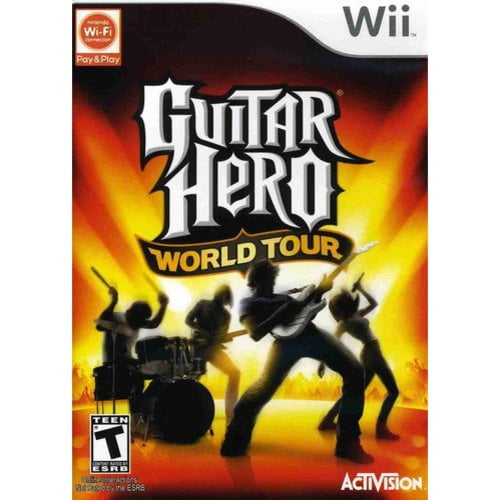

A revamped single-player Career mode lets gamers advance their musician through a series of gigs by playing a specific number of songs with the option to change difficulty level or instrument at any time. The singing mechanic resembles Karaoke Revolution and SingStar in that it requires vocalists to match the pitch and notes of each song, whereas drummers must be timely when depressing the kick drum and striking the proper combination of drum and cymbal pads. As with all titles in the Guitar Hero series, gamers must play their instruments by rhythmically matching onscreen prompts in order to earn high scores and unlock new songs. For the first time in the series, wannabe rock stars can simulate singing and drumming in addition to the familiar strumming of guitar-shaped controllers and with the addition of a bass guitar, up to four players can form a band and jam together.
WII GUITAR HERO WORLD TOUR GUITAR FULL
Since slider notes can be played like regular hammer-ons and pull-offs without requiring strumming, this change reduced the song's difficulty significantly.The first name in music instrument gaming returns with a Rock Band-esque focus on full band simulation, the ability for players to create their own music and more than 80 new tracks in Guitar Hero: World Tour. However, when "Through the Fire and Flames" returned in Guitar Hero Smash Hits, these hammer-on and pull-off sequences are replaced by slider notes. For example, DragonForce's " Through the Fire and Flames" in Guitar Hero III: Legends of Rock features very difficult strings of hammer-ons and pull-offs throughout. While the necessity and usefulness of the slider itself is debatable, the special slider notes are widely considered a godsend on harder songs that feature such notes. Most players who are very good at the game agree that these notes are somehow "broken." This, coupled with the fact that the touch strip is difficult to use efficiently, makes the addition of the slider bar an unwelcome feature to most experienced players. This will count the second red as being hit, but force the player to miss the yellow before it. For example, if the pattern green-red-yellow-red is coming up, even if the player hits the buttons in that order, when they hit the red button the game might think that they are attempting to hit the second red. While there are many theories about what makes these notes so difficult to hit, the most popular theory is that on slider notes, it is possible to hit a note after the note you are attempting to play, and this forces a miss on the current note. This problem is especially noticeable in Guitar Hero World Tour, although it persists to a lesser degree in the later games. However, many players contend that these slider notes are actually more difficult to hit than their normal hammer-on/pull-off counterparts, particularly when using the slider bar. holding the fret buttons and tapping the slider instead of hitting the strum bar, and to create a "slider wah" effect by sliding their finger along the slider during held notes, similar to the whammy bar. Players can also use the slider for "tap strumming," i.e. Also, as the strum bar isn't required for these notes, the player doesn't have to worry about overstrumming. On open notes such as these any button can play it. These notes are identified by a white glow. Open notes which appear on a bass guitar can also be hit with the slider. Slider notes can also be played like Hammer Ons and Pull Offs, however, unlike Hammer Ons and Pull Offs, they can be played without strumming at all. Any notes that appear metallic in color(or semi-transparent on the Wii version), and have a rope connecting them can be played without hitting a first note as opposed to Hammer Ons and Pull Offs. Some controllers which don't have a slider can function the same with the standard five frets at the top of the neck. The slider is located near the base of the neck of a guitar controller. The Slider is a feature that debuted in Guitar Hero World Tour, and has come to use in all Guitar Hero games after it.


 0 kommentar(er)
0 kommentar(er)
